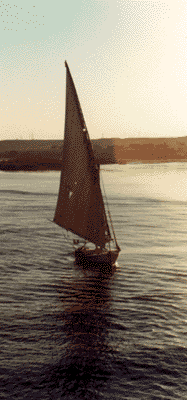
The Nile is pretty incredible. It's got incredible power and is clearly the lifeline to Egypt. Imagine a dry desolate area with no water source and half an inch of rain per year. The only source of water for irrigation and drinking is that from a river that flows from south to north. The summer brings a rise in the river, whose origin is Africa, of about ten feet. The little islands that in the winter have gardens and goats and cattle graze on become submerged. Even today. As recently as two hundred years ago the river would rise twenty to thirty feet, flooding significant areas. The amazing thing is that the Egyptians used it to their advantage. The stones of the Great Pyramids came from a source up the Nile. The stone of this particular region has striations that have "preset" height and the Egyptians would cut the width of the stones. Stones would be loaded on to boats that at the time of cutting the stones were on land. When the summer came and the river rose, the boats would rise with the water then head down the river to the Cairo area! This concept is repeated throughout Egypt's history in the making of the temples and sculptures, as well as with agricultural aspects. Further up the river, Aswan, where the granite quarries are located the landscape changes pretty dramatically. A rugged landscape with a lot of small rocky islands. This is where the obelisks were made and ranged up to 100 or so tons. Again, the obelisks would be sculpted during the winter months and placed on a series of boats tied together. When the summer came with the Nile rising, the boats would float and head down the river!
Aswan is the site of two dams that have changed the character of the Nile. The turn of the century the British put up a dam that regulated the water of the Nile. The same cycle is repeated during the summer, though now not as much water is released. Around this dam there are many rocky islands and in this area the Feluccas are most popular. -An Egyptian rendition of a catboat. Prior to the dam there were a few areas that were considered quite treacherous- cataracts. When the summer months arrive the cataracts are hidden. Only the most experienced boatman could make it through. There are great books that give accounts of going through the cataracts. Strong currents caused by the large rocks. Once the British dam was completed in 1899, the cataracts were pretty much no more. In recognition, a hotel was built and named the Old Cataract. This became a popular hotel that all and any dignitary would stay at if visiting Aswan. The dining room is in an early 1900's style with dome in the center of the ceiling with semi domes around it. The Old Cataract is the opening scene in 'Death on the Nile'. Visitors aren't allowed in this hotel but my mom and I had tea there nonetheless. It's amazing what flashing a travel agent's card will do. We had seen the hotel from the river during our felucca ride and sitting out on the porch was quite a grand way to end the afternoon.
In 1985 a larger and more powerful dam was built and replaced the British dam. The Great Dam, as it is known, is quite spectacular. Both of these dams, especially the Great Dam, have had heavy impact on the shape and character of the Nile. On one side of the dam villages have been flooded and have had to be moved. Some temples also have had to be moved. In the case of Abu Simbel, the spot where Ramses II built a temple for himself announcing himself as God and built a temple in memory of his wife, Nefertari. He had many wives, though Nefertari was his favorite. The temple was built into a mountain. The engineering that went into moving the mountain is absolutely incredible. 42,000 pieces the mountain was hand sawn into and then moved. The landscape in the region is dry and eerie. A lot of pointy mountains that are unlike anything I've seen. This body of water is due mostly to the Great Dam. If were to be bombed the amount of water that is held back by the dam would take 12 hours to reach Cairo, and then wiping it out. People would have to move seven miles away from the Nile for safety, which is well into the desert.
Oh, by the way, the temples were amazing too..